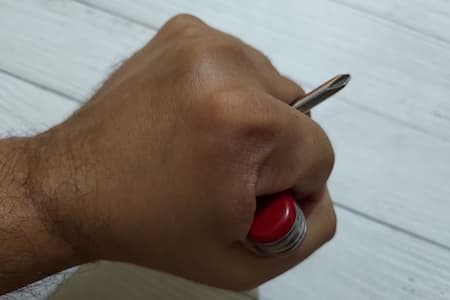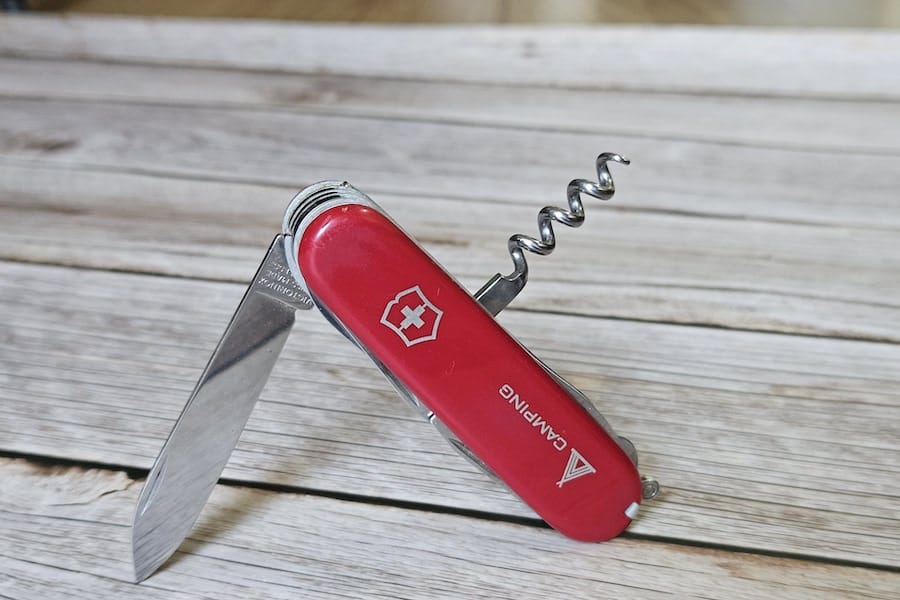Self-defense is a tricky topic. Defending yourself with a tool like a Swiss Army Knife would probably be the last thing in your mind. But what if you are caught in such a situation where you don’t have anything else apart from the trusty old Swiss Army knife in your pocket? Can you use your Swiss Army knife for self-defense?
In an emergency situation, a Swiss Army Knife can be used for self-defense. The tools in a SAK like the blade, the corkscrew, the screwdriver, and the awl can be used as a makeshift weapon to defend yourself, which might just give you a small advantage over just using your bare hands.
This post will cover the practicality of using a Swiss Army Knife as a defensive weapon and the various ways you can use it to defend yourself.
First of all, do understand that a Swiss Army knife is designed as a tool and not a weapon. Don’t get fooled by the word ‘army‘ in the name ‘Swiss Army Knife’. Even though the soldiers in the Switzerland army do use Swiss Army Knives, they use them as a tool and not as a weapon to attack the enemy or fend off an attacker.
In fact, the Soldiers don’t carry those small red-colored SAKs that all of us are familiar with. The standard-issue SAK for the soldiers is a much bigger model, aptly named ‘Swiss Army Knife Soldier 08‘. To know more about the Solider’s knife and its origin, do read: Do the Swiss Army Use Swiss Army Knives?
But we are talking about those 91mm variety of Swiss Army Knives here, the kind that everyone seems to have one, and many carry with them as an EDC. Let’s see some of the ways we can use these pocket-sized SAKs as something to defend ourselves with if the situation demands it.
Using a SAK to increase the rigidity of the fist for punching
Gripping the Swiss Army Knife tightly in your hand would add mass and rigidity to your fist when striking. The size and shape of a 91mm SAK are just right to reinforce a good strong punching fist. Grasping it tightly will provide good support to your fist.
It is also easy to grab the SAK quickly in this manner. As such, this is perhaps the most effective way to use the SAK in a fistfight.
This is quite practical because in an emergency situation, you might not have enough time to deploy any of the tools in the SAK.

Of course, it will be effective to use the SAK this way if you are somewhat trained in hand-to-hand combat.
Using the SAK like a hammer
This is an improvisation of the first technique. While holding the SAK in your grip, keep one end exposed and protruding. You can then use that exposed metal/plastic end as an impact hammer while hitting your opponent.

Hitting your opponent like this will surely do more damage than just using your naked fists.
Using the SAK Corkscrew or the Screwdriver as brass knuckles
This is perhaps the best way to do some significant damage in hand-to-hand combat. All Swiss Army Knives has either a corkscrew or a Philips screwdriver.
Since the tool is positioned in the middle of the SAK body, you can clench the SAK in your fist with the corkscrew or the screwdriver open and sticking out from between your fingers below the knuckles. This would work as makeshift brass knuckles, but very effective nonetheless.


If you can use it in this manner, it is guaranteed to do much more damage than your bare fists. Holding the SAK this way will also protect your hand and at the same time strengthen the impact of your punch. Of course, this technique may also require that you are somewhat trained in combat.
Using the SAK Awl as brass knuckles
You will find many people advising the awl to use as a weapon in emergency situations. The technique is the same as the one with the corkscrew or the screwdriver – using the awl as you would use brass knuckles.
The awl being pointed and sharp will probably be more effective than the corkscrew or the screwdriver. You can punch and also slash with it, which will surely do much more damage. But there is a glaring drawback in applying this technique.
One side of the awl is very sharp. When you are punching and swinging your fist, the impact will surely make the awl cut and dig into your fingers. This is inevitable, as the awl cannot be locked into its position.
You may want to file down the sharp side of the awl to avoid this. But that will also reduce the effectiveness of the awl as a tool.
Using the SAK blade for Slashing
Most 91mm Swiss Army Knives have non-locking blades. As such, it is extremely difficult to use the blade as a weapon. The blade is almost certain to close on your fingers while using it as a weapon, thereby causing significant injury to yourself rather than hurting your opponent.
As such, it is always better to avoid using the blade of a Swiss Army Knife as a defensive weapon. Any type of self-injury will give your opponent an upper hand.
But it is a blade, right? and a very sharp one indeed. It is also the longest tool in a Swiss Army Knife. So is there a way it can be made useful as a defensive weapon?
People who are extremely adept at using any kind of tool as a weapon and have adequate fight IQ will be able to do serious damage with the blade in a Swiss Army Knife. They would probably use the blade like a scalpel rather than a knife and use it with extreme precision to cut tendons or muscle groups that would paralyze their opponent.
This of course requires proper knowledge of the human body including the weak and most vulnerable areas.
It would be something like a surgeon working with extreme precision.

A scalpel grip with the index finger at the back of the blade will render the blade impractical for stabbing. But it would make an excellent slicing weapon in the hands of an expert. He would probably target the tendons in the hand or forearm or above the knee to leave his opponent unable to use his arms or even stand on his feet.
When to use a Swiss Army Knife for Self-defense?
A Swiss Army Knife is a lousy self-defense weapon at best. Most people will hurt themselves more while using a SAK as a weapon for self-defense. Avoiding a confrontation that may lead to a dangerous situation should always be the first priority.
However, if the situation becomes unavoidable and there is a genuine threat to your life or the life of your near and dear ones, you should use anything and everything you can for self-defense. The threat can be from humans, wild animals, or even street dogs that gang up on you.
If the Swiss Army Knife in your pocket is the only thing you have got, and you think it can give you even a slight advantage, you should definitely use it.
Using the 111mm and 130mm Swiss Army Knives for Self-Defense
The bigger SwissArmy Knives, especially the 111mm and the 130mm ones are much better suited for self-defense. This is because the blades in these SAKs are larger, and more importantly, all of these models have locking blades. Many models also have a one-handed opening mechanism. All of these immediately make such a SAK a pretty good offensive or defensive weapon.
The SAK that a soldier of the Switzerland army uses is a 111mm model. Though they mostly use it as a tool, it is strong enough to be used as a weapon if the situation demands it.
This SAK is also better designed with a grippy handle.

In fact, most of the Swiss Army Knives that are good for outdoor activities like bush-crafting or hunting will probably do an adequate job as a weapon of self-defense.
Final Thoughts
A Swiss Army Knife is an extremely versatile tool with many applications. But using it as a weapon is probably not one of them. Most people will fail to use a Swiss Army Knife as a weapon, defensive or otherwise.
But that does not mean a Swiss Army Knife cannot be used for self-defense. Is it ideal? definitely not. But you can sure make it work to your advantage if you know how to use it in a situation that demands it.
In fact, this is the reason why SAKs are prohibited to be carried with you in the cabin on a flight. These are also not allowed in government buildings, schools, or places of worship.
Anything with a sharp edge or pointy end can be used as a weapon to defend yourself. A Swiss Army Knife is no exception.






